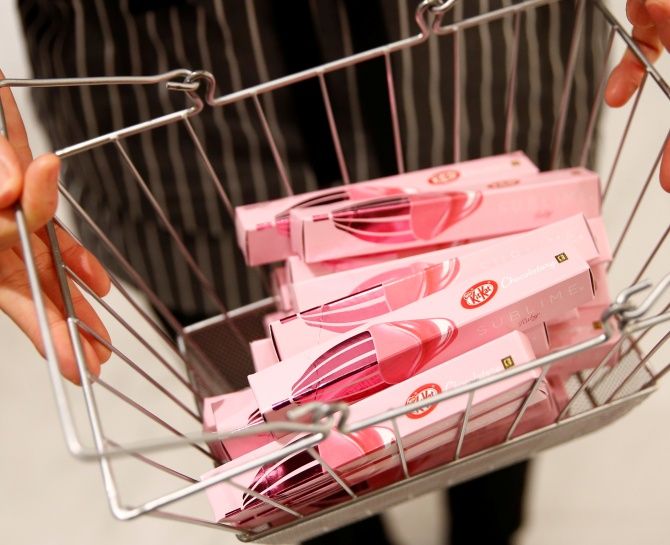Japan today imports 500,000 tons of coffee annually.
Barely 60 years earlier, it was a market that hardly sold a cup!
Ad guru Sandeep Goyal reveals how Nestle won the Coffee versus Tea Battle.

The Flavour of Green Tea over Rice was an epoch making film produced in 1952 by the famous Japanese director Yasujiro Ozu.
Besides being a cult film that questioned bourgeois elitism in post-Second World War Japan, it explored the ideological dilemmas of post-war economic recovery and prosperity.
The most interesting perspective of the film, however, was actually in the film's title: The comforting taste, and flavour, of green tea poured over rice. A Japanese all-time favourite.
For most Indians, such a flavour would be completely outside their experience set, let alone provide any comfort or solace.
And thereby hangs a very interesting tale, of Japan, from Japan, but universal in its lessons, on acquired tastes.
I first heard this story maybe 25 years ago from my mentor Fumio Oshima who led the Nestle business at Dentsu Tokyo for almost two decades.
In post war Japan, many Western companies saw meteoric growth. But Nestle struggled with their flagship product: Coffee.
Nestle had brought coffee to Japan post World War II in the hope that it would be a huge market to exploit; the company developed a seemingly great product; priced it really affordably; its taste tested well with its intended audiences; but sales never really took off.
No amount of advertising, or sampling, or promotions helped.
Japan was a tea-drinking nation, with no familiarity to coffee, and no fondness for its taste. The brand managers were perplexed, totally frustrated.
In 1975, the famous French psychoanalyst, Clotaire Rapaille, was invited to Japan by Nestle.
Rapaille was well known for his research on the emotional bonds humans form with objects in their culture.
He was asked to look at the problem of the Japanese not taking to coffee despite much advertising, and persuasion.
The Frenchman assembled several large groups of Japanese and got them to participate in some 'stimulus experiments'.
He played soothing music and got them to talk back through their earliest childhood memories.
After that, he asked them to describe their experiences with different products and what emotions they associated with them.
He then asked them about their experiences with coffee -- but he got no response. Most had no memories of coffee.
They'd never tasted coffee, hence had no emotional bond to the drink. Why?
Because in Japan they only drank tea; had been doing so for thousands of years.
Coffee was a recent foreign phenomenon with no accumulated repository of past memories.

This was the critical insight Rapaille was looking for. He went back to the brand custodians at Nestle Japan and said please don't throw endless advertising dollars at converting the Japanese public to coffee. Your problem is much deeper.
Instead, he suggested a much longer term strategy. He asked Nestle to focus on coffee-flavoured candies and market them to Japanese children.
Rapaille's hypothesis was that what was needed was to get the children to love Nestle's coffee flavour from an early age.
Not only would this condition them to the taste, it would also imprint the flavour in their minds and memories. They would start to associate coffee with positive emotions.
This imprinting strategy worked doubly well because Nestle, as it is, was a proven global leader in making good candy.
Nestle Japan flooded the market with their coffee-flavoured candies which immediately became extremely popular with Japanese youth.
The secondary effect of the candy push was the filtering up of the coffee flavour to their parents, who ended up tasting the candies out of curiosity, and started to like them too.

A decade later, Nestle re-entered the Japanese market with a new wave of coffee offerings. This time, thankfully, the outcome would be very different.
Many of their candy customers were now of working age. They were already consumers of caffeine and worked long hours.
Nestle released instant baristas that were easy for home and workspaces. Instant coffee was a thunderous success. The rest, as they say, is history.
Today, Nestle is the undisputed market leader in that geography. Japan today imports 500,000 tons of coffee annually. Barely 60 years earlier, it was a market that hardly sold a cup!
Patience. Practicality. Prudence. Perseverance. Penetrative insights.
Rapaille delivered for Nestle Japan one of the most profound case-studies of modern marketing, underlining the strong correlation between consumer psychoanalysis, its manifestation in visible behaviour patterns and how smart marketers can pivot marketing strategies to advantage by fully understanding how consumers think, behave and buy.
The flavour of green tea over rice is still a Japanese favourite. But in less than half a century, a mere couple of generations, coffee too is an integral part of the Japanese palette.
Nestle repeated the coffee learning with noodles in India. Most of India had never tasted noodles. But Maggi noodles targeted kids, won over mothers.
In three decades all of India is addicted!
Feature Production: Rajesh Alva/Rediff.com











